Best Cell Service in Your Area - Carrier Coverage Map
Which Carrier Has the Best Cell Service in My Area? 2024 Edition
With so many cellular carriers to choose from, don’t we all want to pick the one with the best service in our area? Selecting the best carrier for you isn’t just about the best overall coverage. It’s about which carrier is going to keep you connected where you spend most of your time.
Between Verizon, AT&T, T-Mobile, and US Cellular, our cell phone coverage map comparison will show which service provider offers the best cell service. Find sources for statistics and data at the end of the article.
We fix poor cell phone signal! Find the right signal booster for you:




In this guide:
- Verizon Wireless Cell Phone Coverage Map
- AT&T Cell Phone Coverage Map
- T-Mobile Cell Phone Coverage Map
- US Cellular Cell Phone Coverage Map
- MVNO Cell Phone Coverage
- Frequently Asked Questions
Verizon Wireless Cell Phone Coverage Map
Verizon has the best 4G LTE coverage that spans across 70% of the United States. That's 2% more than AT&T and 8% more than T-Mobile. It covers 327 million people in over 2.68 million square miles.
Depending on your location, you may even get Verizon 5G cell service. It’s available in about 13% of the US, lagging behind T-Mobile and AT&T. You'll need a 5G-compatible device and phone plan to connect.
When compared to the other major US carriers, Verizon's 5G network experience was unmatched.
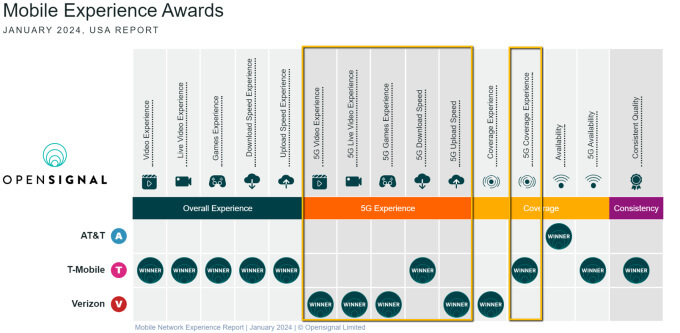
Verizon’s coverage map shows more reliable 4G and 5G coverage on the Eastern side of the country. This makes sense, as the Eastern United States is more densely populated, and the Rocky Mountains are far taller and more infrastructure-intense than the East’s Appalachians.
Coverage is slightly lacking in some Western states, predominately rural areas. 5G is currently only available in select areas.
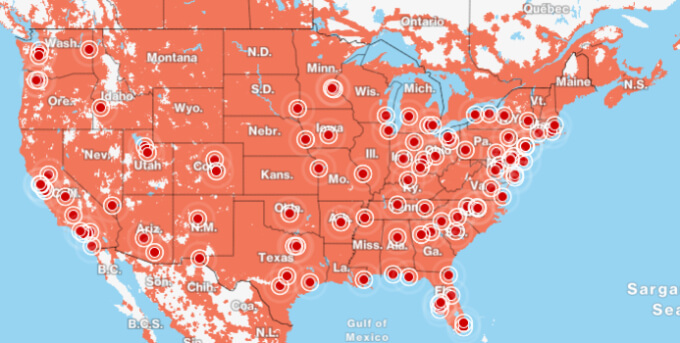
Explore Verizon’s coverage map to see if their 4G/5G cell service is available in your area.
On average, reports state Verizon users stayed connected 99.3% of the time, just slightly behind AT&T. An active 5G connection was only available 7.7% of the time, lagging behind both AT&T and T-Mobile. Since they have the lowest 5G footprint, this is expected. The typical everyday download speeds subscribers experience across Verizon's network clock in at around 42.6 Mbps. When connected to 5G, download speeds average 150.5 Mbps.
Verizon’s prices reflect its cell service dominance, having the highest rates for its reliability and superior coverage. For great coverage and lower rates, consider Visible, their MVNO carrier.
If you find yourself outside of Verizon’s coverage or in buildings that block that otherwise reliable signal, a cell phone signal booster can help enhance your reception.
Overview:
- #1 in 4G Coverage
- #2 in 4G and 5G Cell Service Connectivity
- #2 in Average 5G Download Speeds
- #3 in 5G Coverage
- #3 in Average 4G Download Speeds
AT&T Cell Phone Coverage Map
AT&T ranks second in 4G and 5G coverage. Its 4G network is available across 68% of the US. AT&T 5G is only available across 29%, reaching more than 300+ million people in more than 25,200 cities and towns. Big Blue is constantly working on expanding its 5G and 5G+ coverage footprint.
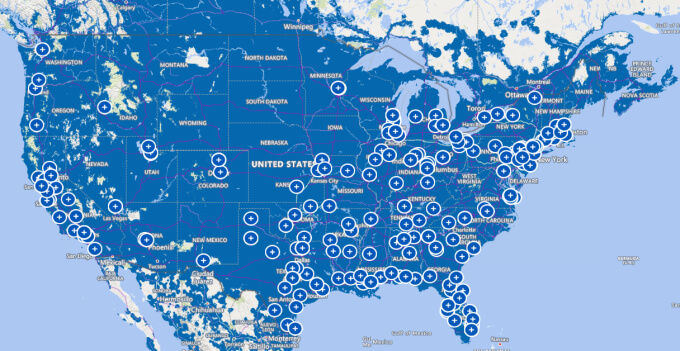
Verizon and AT&T’s coverage maps look very similar. Differences lie in remote and rural areas. To ensure AT&T covers the areas you frequent, check out AT&T’s 4G and 5G coverage map.
Mobile experience reports state AT&T users enjoy a reliable connection 99.5% of the time, surpassing Verizon and T-Mobile. This means AT&T subscribers spend the largest amount of time connected to the network in the places that matter. A 5G connection was available about 11.8% of the time.
AT&T also delivers faster speeds than Verizon, but not as fast as T-Mobile. On average, users experience download speeds of 49.9 Mbps across 4G and 5G networks. When connected to only 5G, download speeds averaged 142.1 Mbps.
Overview:
- #1 in 4G and 5G Cell Service Connectivity
- #2 in 4G and 5G Coverage
- #2 in Average 4G Download Speeds
- #3 in Average 5G Download Speeds
To tap into AT&T’s 5G cell service where it’s available, 5G phones and plans are required. Check out Red Pocket Mobile and Cricket Wireless for similar connectivity at a lower cost.
T-Mobile Cell Phone Coverage Map
T-Mobile's 4G network coverage falls behind AT&T and Verizon. It covers 62% of the US. That’s 8% less than Verizon and 6% less than AT&T.
The Un-carrier makes up for the incremental 4G coverage difference in other areas. They have the largest 5G network and fastest data speeds
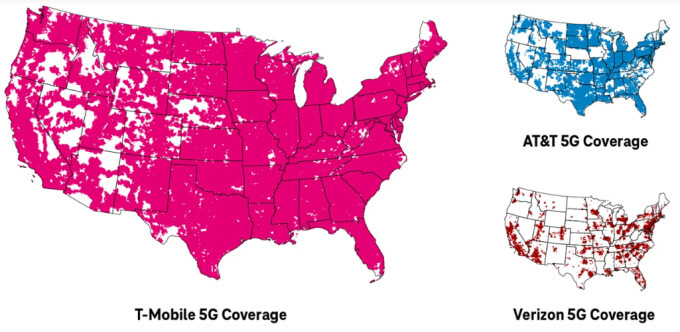
The T-Mobile and Sprint merger expanded T-Mobile's coverage footprint and set them up to build the largest, most reliable 5G network. Thanks to the merger, T-Mobile aims to deliver 14x more network capacity, 15x faster speeds, and 5G for 99% of the US population (including rural America) within the next 6 years.
Currently, T-Mobile's 5G blankets 53% of the US, delivering reliable 5G to over 330 million people. That's 41% more coverage than Verizon and 24% more than AT&T.
Check out T-Mobile's coverage map to see if they offer 4G or 5G cell service near you.
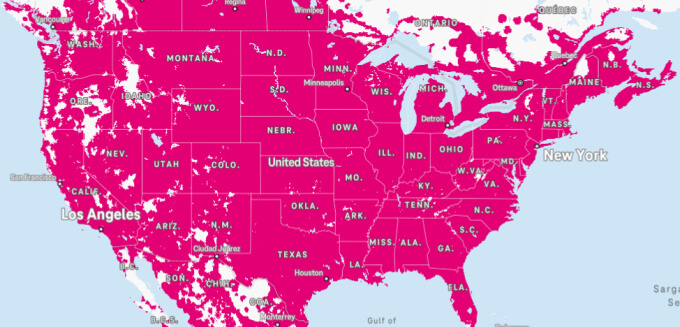
T-Mobile has the least coverage in rural areas. However, their partnership with Starlink is expected to change that. Using SpaceX’s satellites, T-Mobile plans to provide near-complete coverage everywhere. In January 2024, the first Direct to Cell satellite was launched into orbit, and it works for texting.
Users report reliable 4G/5G cell service 98.7% of the time, putting it a tad behind Verizon and AT&T. When it comes to a consistent 5G connection, T-Mobile leaves all carriers in the dust. Subscribers remain connected to T-Mobile's 5G cell service 67.9% of the time.
While T-Mobile may not have the largest coverage footprint, it dominates in data speeds. Subscribers enjoy average 4G/5G download speeds of 139.3 Mbps, with 5G speeds clocking in at 226.7 Mbps.
To access T-Mobile's superior 5G network, you need a 5G phone and cell phone plan.
For lower cost options, consider T-Mobile's MVNO carrier, Mint Mobile.
Overview:
- #1 5G Coverage
- #1 in Average 4G and 5G Download Speeds
- #1 in 5G Cell Service Connectivity
- #3 in 4G Coverage
- #3 in 4G Cell Service Connectivity
US Cellular Cell Phone Coverage Map
With Sprint out of the picture, US Cellular is the fourth-largest mobile network with the least coverage footprint. Respectively, US Cellular’s 4G network covers about 10% of the country, with 5G covering even less.
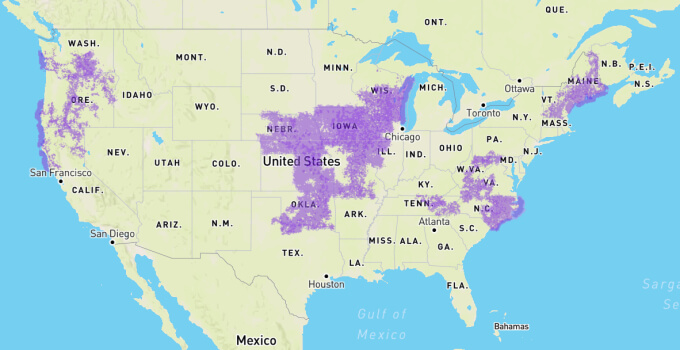
To achieve nationwide coverage, they have roaming agreements with Verizon, AT&T, and T-Mobile. Subscribers can roam on partnering 4G and 5G networks to remain connected when US Cellular service isn’t available at no extra cost. The coverage map on US Cellular’s website reflects their core network and roaming network combined.
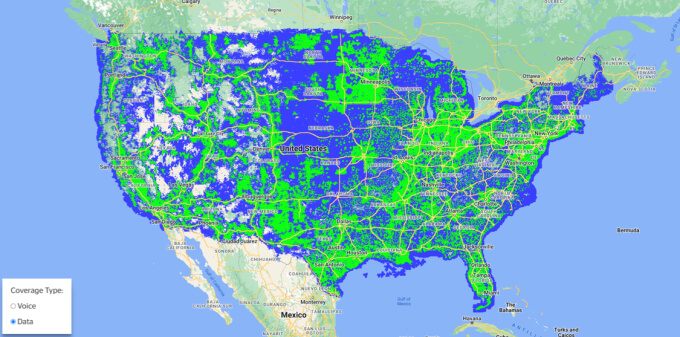
Just because US Cellular devices can access Verizon, AT&T, and T-Mobile networks doesn’t mean great cell service anytime anywhere. Because the device enters roaming mode outside the core network, reception may be of lower quality. A signal booster can help improve US Cellular voice and data reliability at home or on the go.
Overview:
- #4 in 4G Coverage
- #4 in 5G Coverage
MVNO Cell Phone Coverage Maps
Mobile virtual network operators (MVNO), also known as prepaid carriers, offer similar coverage as their parent company at more affordable prices. Although, deprioritization is common during times of congestion. Parent carriers prioritize their service to their direct subscribers. Here is a list of different MVNO carrier coverage maps:
- AirVoice Wireless
- Boost Mobile
- Consumer Cellular
- Cricket Wireless
- Google Fi Wireless
- h2o Wireless
- Metro by T-Mobile
- Mint Mobile
- Spectrum Mobile
- Straight Talk
- Tello Mobile
- Ting Mobile
- Total Wireless
- Tracfone
- US Mobile
- Visible Wireless
- Walmart Family Mobile
- Xfinity Mobile
Which Cell Phone Carrier Has the Most Cell Phone Coverage?
Verizon continues its stronghold on the top spot for 4G cell phone coverage. However, its competitors continue offering comparable coverage at more affordable prices. If you're looking for the best 5G coverage, T-Mobile is the way to go.
Which Carrier Has the Best 5G Coverage?
Hands down, T-Mobile.
Each carrier has two versions of 5G. One offers broader coverage but slower speeds. The other one offers faster speeds and greater capacity but less coverage. Each covers different amount of people.
- Verizon's 5G reaches over 230 million people, while its 5G Ultra Wideband reaches over 200 million.
- AT&T's 5G reaches over 300 million people, while its 5G+ reaches over 230 million.
- T-Mobile's 5G Extended Range reaches over 330 million people, while its 5G Ultra Capacity reaches over 300 million.
T-Mobile 5G is available to more people and offers the fastest speeds and most consistent connection. This makes it the winner of best 5G coverage. However, keep in mind that reception will vary by location.
Which Cell Phone Carrier Has the Best Nationwide Cell Phone Coverage?
Just because one wireless carrier has the most coverage, doesn’t mean they offer the best. To crown the carrier with the best coverage, we looked at Open Signal’s coverage by availability analysis. It measures what proportion of time people have a network connection in the places they most commonly frequent.
Available 99.5% of the time, AT&T's network wins best coverage. These results represent the proportion of time AT&T users had a 3G, 4G, or 5G connection. Though, 3G has been discontinued.

For strictly 5G availability, T-Mobile is the champion. However, it's not surprising since they have the largest 5G coverage.

This does not mean, that AT&T or T-Mobile have the best coverage by availability everywhere. There may be some areas where Verizon is much stronger and reliable than T-Mobile or AT&T.
Which Cell Phone Carrier Has the Best Cell Coverage in My Area?
To narrow down which carrier offers the best coverage in your area, you can look up your address on their coverage maps.
They’ll disclose estimated 4G and 5G availability in your area.
For more consolidated results, check out CoveragMap.com. You'd simply enter your state, city, or zip code in the search bar to view the carrier with the best coverage in your specific area. Results are based on crowd-sourced speed test maps and signal strength data from the FCC.
Another option is the FCC’s Mobile LTE Coverage Map. It’s designed to show customers where voice and mobile data are expected to be available for AT&T, Verizon, T-Mobile, and US Cellular in one single place. Unfortunately, 5G network information is not available.
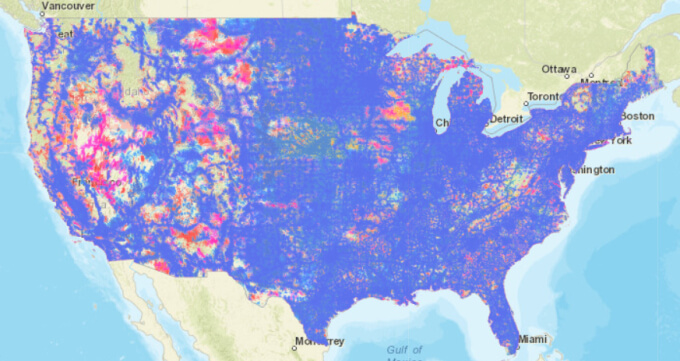
Their National Broadband Map reflects where 4G and 5G data should be available while stationery outdoors or in a moving vehicle. To find which carrier offers the best coverage in your area:
Step 1: Click “Providers”.
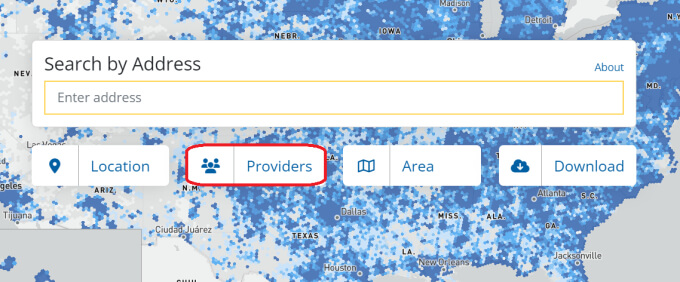
Step 2: Click “Mobile Broadband” and then “Add Provider”.

Step 3: Add up to three cellular providers, select mobile technology, and click “Save”.
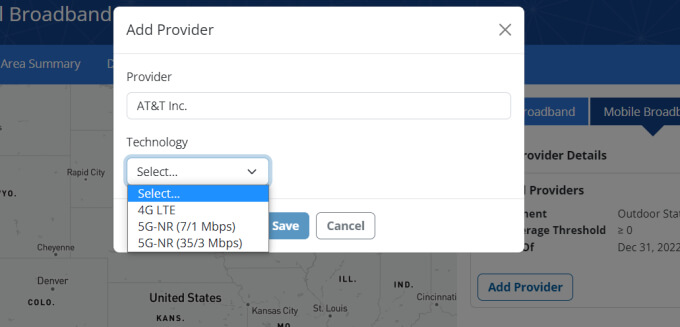
Step 4: Zoom into your location and analyze results. You can easily toggle each carrier on and off as needed for better visualization. The chart displays the percentage of area covered by each carrier with the selected technology. Clicking the gear icon on the top right allows you to switch between “Outdoor Stationary” and “In-Vehicle Mobile”.
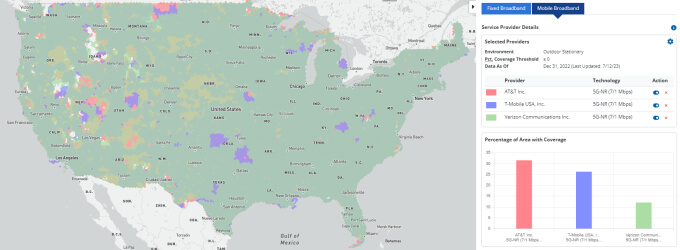
However, these maps do not show signal strength or cell tower location. That information can be used to choose the carrier that best fits your needs. In other words, best cell phone coverage does not equate to best cell phone service or strongest cell signal.
How Can I Find the Carrier with the Best Cell Service in My Area?
Cell phone coverage maps show estimated 4G and 5G coverage availability. Just because they say your area is covered and win best coverage, doesn’t mean they are the best provider with the best cell phone service in your specific location. The most reliable way to find the cell phone provider that offers the strongest cell signal in areas you frequent, like your home or workplace, is by using crowdsourced third-party cell phone coverage sources.
Our number one recommendation is the OpenSignal app, available on Google Play and the App Store. It features crowdsourced 4G and 5G coverage maps from multiple cell phone providers based on data speeds. Clicking the magnifying glass allows you to search by city. The carrier that offers the fastest data speed is the best one in your area.
Lastly, launching in Q2 of 2025 is an exceptional new product that solves all of the issues of finding your carrier cell tower. Cellular Path's new product is a self pointing cellular antenna that automatically scans and positions your antenna. Once the antenna and rotator are installed you. can also reposition them remotely via their app. Cool Stuff.
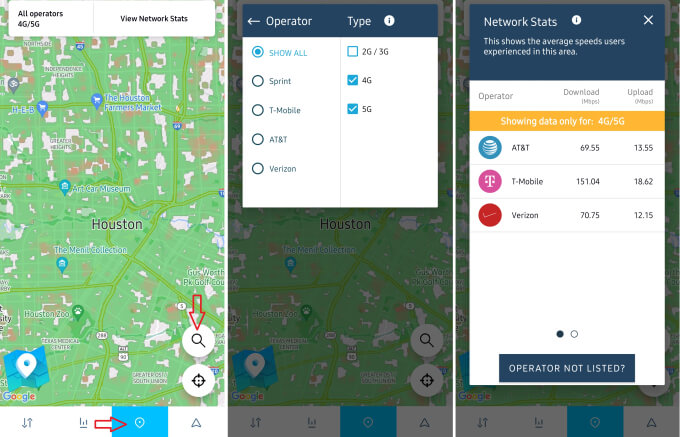
Signal Checker is another popular source, though it is not our favorite. It allows you to check cell coverage by zip code or place with one search. The results show what networks and carriers are available in specific locations. However, it doesn’t clarify which carrier offers the best cell service.

Which Cell Phone Provider Has the Best Cell Service Per State?
OpenSignal breaks down which cellular provider offers the best phone service per state in their 2024 Mobile Network Experience Reports. Here are the results:
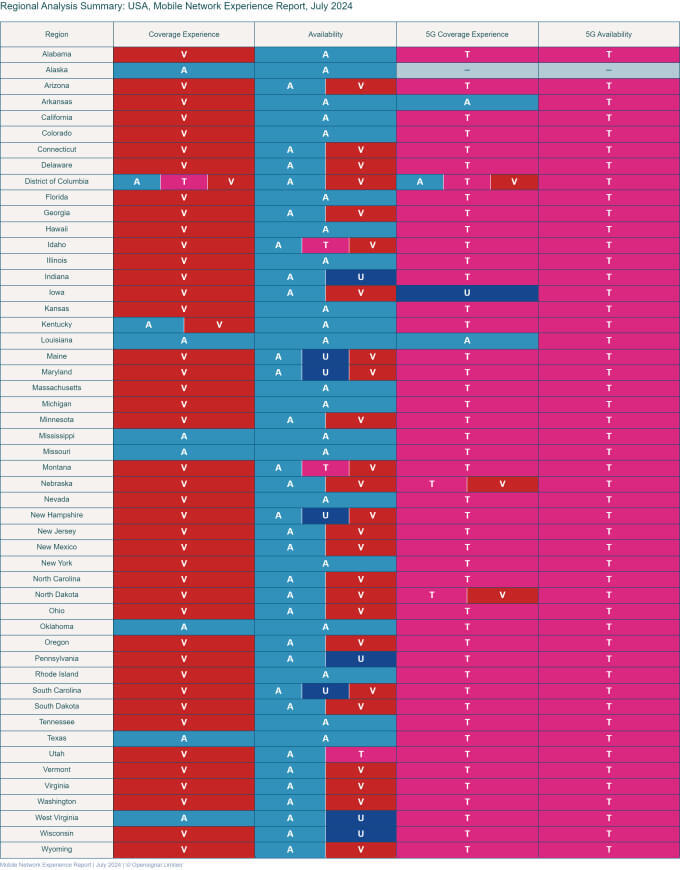
Which Cell Phone Provider Has the Best Cell Service in Rural America?
Rural America faces the most cellular signal challenges. Cellular infrastructure is often lacking. PCMag’s Best Mobile Networks test reveals which carrier has the best cell service in six rural regions. While a bit outdated, it’s a great baseline. They tested call reliability and data speeds.
| Rural Region | Best Mobile Network |
| Northeast Rural America | T-Mobile |
| Southeast Rural America | Verizon |
| North Central Rural America | Verizon |
| South Central Rural America | AT&T |
| Northwest Rural America | AT&T |
| Southwest Rural America | AT&T |
Why Don’t I Have Good Cell Service Even Though Coverage Map Shows I Should Have Signal?
So, you checked your cellular provider's coverage map, as well as others, and saw that you should be covered. HOWEVER, cell reception is less than decent. You might be wondering if your carrier provider is at fault for bad cell phone service in your area.
While it's tempting to blame your carrier for poor coverage, many factors contribute to cell signal issues.
Throttling and prioritization, for one, often result in unsatisfactory service. Thus, many point the finger at their carrier for dropped calls and slow data even though carriers disclose said info on all plans.
Other factors that affect your cell signal, which are out of your carrier's control, might I add, are:
- Your Phone’s Age: Newer phone models receive much better reception than older devices. As networks (LTE, 4G, 5G), evolve, so do cellular devices. They're able to tap into newer frequencies and maintain a better connection.
- Blocking Phone’s Antenna: Phone antennas are small and internal, allowing cellular devices to be visually appealing and compact. However, this makes it easy to block the antenna with thick or metal cases, as well as your hand. As a result, the antenna will struggle to send or receive a strong signal.
- Enabled WiFi: When your WiFi is on, your device will try to access a WiFi network before cellular. This causes your phone to run slow, and sometimes if the phone doesn’t find a WiFi connection, it won't load at all.
- Obstacles: Building material and topography kill or weaken incoming signals. Thus, limiting cellular coverage inside your home, office, or vehicle.
- Cell Tower Distance: The farther you are from a cell tower or small cell, the weaker the incoming signal becomes. Obstacles further degrade the signal. Tower distance tends to be the main cause of bad cell reception in rural areas.
It’s difficult for cellular carriers to take every possible variable into account and reflect it on their coverage maps.
To overcome tower distance and obstacle challenges, cellular repeaters can help regardless of which carrier you have. They use powerful equipment designed to amplify your cell signal and broadcast it where you need it.
At Your Wits End with Your Carrier’s Coverage and Cell Service? What Does it Cost to Switch Carriers?
If you’ve tried everything to improve your cell signal to no avail, then it may be time to change cell carriers. Let’s look at how much it costs to break up with your carrier:
- Early termination fees may apply if you signed up for a contract that you haven’t yet fulfilled. Those charges alone can cost you up to $350, depending on your carrier and how far along you are in your contract. Some mobile carriers offer to pay off early termination fees to gain your business. Just make sure you know all the details about the process. You may be required to pay the fees upfront, and your new carrier will reimburse your account after a certain period as long as you meet their terms.
- You’ll have to pay off your cellular device(s) before switching carriers. Most carriers offer installment plans, allowing you to slowly chip away at the large price tag. They also offer attractive deals, like BOGO or a free device with a new line, to get you to open an account, upgrade, or add a line. To take full advantage of the promotion, you're required to have the lines and devices active for a certain amount of time. Depending on the remaining balance of your $1,000+ smartphone(s), this has the potential to be a costly expense. Failure to pay the balance will cause challenges when porting your number to a different carrier. It could even result in blacklisting your device.
- Starting service with a new carrier comes with additional expenses, like activation fees, down payment on a new phone(s), and plan costs.
For those who own weBoost or WilsonPro signal boosters, they are compatible with all carriers. You don’t have to worry about making the switch. If you have yet to invest in a signal booster, it’s a wise option to consider before switching cell phone service provider.
The right booster will capture existing signals, amplify them, and re-broadcast your new, superpowered signal directly to your mobile devices. Plus, it may be a more economical option since it’s a one-time purchase without monthly fees.
Which Mobile Network is Most Reliable?
Signal reliability will vary by location. Even the most comprehensive service will have some blind spots. There are also some areas that are so remote that none of the major carriers prioritize coverage there. Make sure to explore coverage maps to find the right provider for you.
Though, based on Open Signal’s coverage availability national analysis, AT&T offers the most reliable network by a minuscule amount.
How to Improve Cell Phone Coverage and Cell Service Strength Inside Buildings?
You might find that cell phone reception is far superior outdoors than indoors. This is due to building materials, cell tower distance, and obstacles, affecting indoor coverage. There is not much cell phone providers can do to fix this challenge, but a cell phone signal booster can. They will take your outside cell signal and deliver it even stronger inside.
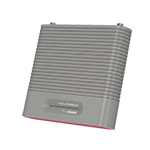
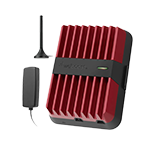
Voice, call, and text all get the boost they need to keep you connected, even in the face of natural and man-made obstructions. Performance will depend on the strength of your outside cell phone signal.
Find the perfect signal booster for your home, business, or vehicle (including everything from cars and trucks to big rigs and boats). Email (sales@wilsonamplifiers.com), call (1-800-568-2723), chat or take our quiz for a personalized recommendation.
Sources
- 2024 Mobile Network Experience Report | OpenSignal
- US Cellular Coverage Map | WhistleOut
- US Finding Best Cell Coverage Guide | Reviews
Interested in Learning More? Check Out Our Signal Boosting Info Center


Money Back Guarantee

Technical Support